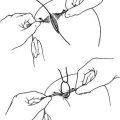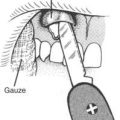INHALATION INJURIES
Inhalation injuries include thermal (heat) and chemical (smoke, noxious gas) inhalations. A third type of inhalation injury is aspiration (inhalation) of stomach contents; blood; or ocean, river, lake, or pool water into the lungs. The severity of the injury is determined by the chemical nature of the substance, temperature, volume of inhaled material, and underlying health of the victim. In a likely scenario, such as a boating accident or a seizure that occurred in the water, you must have a high index of suspicion for an inhalation injury. Drowning is discussed on page 406.
THERMAL INJURY
The heat injures the inside of the mouth and nose, throat, vocal cords, trachea, bronchi, and occasionally lungs. External signs of an inhalation injury include burns of the face and mouth, singed nasal hairs, and soot in the mouth and nose. Symptoms include shortness of breath; wheezing; coughing (particularly of carbonaceous black sputum); raspy, coarse breathing (stridor) noted most often during inspiration, with a barking quality that seems to originate in the neck; muffled voice; drooling; difficulty swallowing; swollen tongue; and agitation.
Once the burn injury has occurred, there is no effective way to limit its progress, so the victim should be transported as rapidly as possible to an emergency facility. If oxygen (see page 431) is available, it should be administered at a flow rate of 5 to 10 liters per minute by face mask. If the victim’s condition deteriorates rapidly because the airway becomes swollen and obstructed, the only hope for survival is the placement of a tube directly through the vocal cords and into the trachea, or the creation of an air passage through the neck (tracheotomy).
SMOKE (CHEMICAL) INJURY
Most smoke is composed of soot and various chemicals. Although each specific substance causes its own variation on the basic lung injury, the immediate first-aid approach is the same: Remove the victim from the offending agent, and immediately administer oxygen at a flow rate of 5 to 10 liters per minute (see page 431) by face mask. If the victim is having difficulty breathing or is without respirations, he should be supported with mouth-to-mouth breathing (see page 29). Difficulty in breathing may be delayed for a few hours after smoke inhalation, so a victim should seek immediate medical attention even if he feels fine initially.
The utmost caution must be exercised when removing a victim from the source of suspected toxic gases, so as not to create additional victims. Rescuers should wear gas masks if they are available. Carbon monoxide intoxication is discussed on page 334.
What’s in the smoke? Some of the combustion products of concern include these classes of materials: particulate matter (organic and inorganic), carbon monoxide, ozone, organic acids, polynuclear aromatic hydrocarbons, volatile and semivolatile organic compounds, and free radicals. These are present or absent in varying degrees depending on the fuel burned, temperature of the fire, suppression method(s) used, and other factors. Therefore, the toxicity of the smoke may vary, but for the purposes of this discussion, all smoke from wildland fires should be considered comparable.
Prevention is key. One must know how to limit exposure to smoke:
1. Pay attention to local air quality reports, and to the Environmental Protection Agency’s Air Quality Index (AQI). Stay alert for any news coverage or health warnings related to smoke. Use visibility guides, if they’re available. Not every community has a monitor that measures particle levels in the air. In the western United States, some areas without air quality monitors have developed guidelines to help people estimate the AQI based on how far they can see.
2. Common sense is the cornerstone of everything we do in wilderness medicine. If it’s smoky outside, do not plan to exert yourself. Do not run the race, and consider keeping your children indoors. If you develop smoke-related symptoms, curtail any contributing activities and seek an environment away from the smoke. Ordinary dust masks are designed to filter out large particles, so do not count on them to diminish exposure to small particulate matter found in smoke.
3. The air indoors is also important during times of high smoke levels outdoors. So, you should keep indoor air as clean as possible. Unless it is extremely hot outside and you need to open windows and doors for air circulation, you should keep them closed. If you have an air conditioner, allow it to run, with the fresh air intake closed and the filter clean. Certain air cleaners might decrease particulate matter indoors, but be certain that the device does not emit ozone. Do not smoke tobacco products, and do not burn anything that will emit smoke. If it becomes too hot inside a building or enclosure, find a cooler shelter, so that you are not overcome by the heat. When driving a car in smoky areas, keep the windows and vents closed.
AIR QUALITY INDEX (AQI) FOR PARTICLES
• 0 to 50 (Green): Good. Air quality is considered satisfactory, and air pollution poses little or no risk.
• 51 to 100 (Yellow): Moderate. Air quality is acceptable; however, for some pollutants there may be a moderate health concern for a small number of people.
• 101 to 150 (Orange): Unhealthy for Sensitive Groups. Members of sensitive groups may experience health effects. The general public is not likely to be affected when the AQI is in this range.
• 151 to 200 (Red): Unhealthy. Everyone may begin to experience health effects. Members of sensitive groups may experience more serious health effects.
• 201 to 300 (Purple): Very Unhealthy. This triggers a health alert, because everyone may experience more serious health effects.
• 301 to 500 (Maroon): Hazardous. This triggers health warnings of an emergency nature. The entire population is more likely to be affected.
ASPIRATION INJURY
Vomiting and inhalation of stomach contents is a common complication of severe hypothermia or drug overdose, and often follows head injury. The key factor is altered mental status, because a person who has a depressed level of consciousness does not protect his airway. In any situation in which a victim is unconscious and prone to vomit, and the neck is known to be uninjured, place the victim on his side so that vomitus and blood will drain from his mouth to the ground, rather than into his lungs. If you suspect a neck injury, and the victim must be kept on his back with the neck immobilized, keep constant watch for vomiting. If the victim vomits, he must be quickly turned on a stretcher or backboard or logrolled (see page 39), and his mouth manually cleared of debris.





